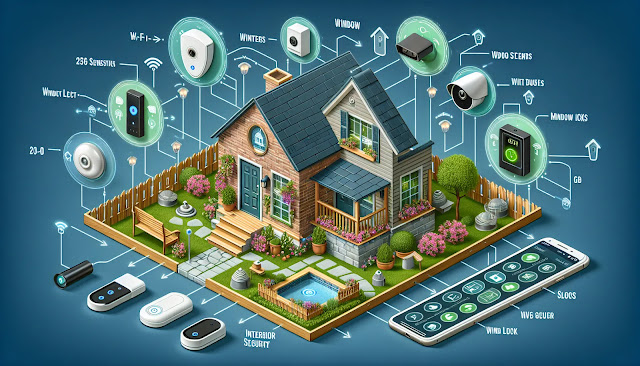Choosing Your First Smart Home Devices: Tips for Beginners
Introduction
Welcome to the world of smart home devices! If you're a beginner looking to dip your toes into the world of home automation, you've come to the right place. In this article, we will guide you through the process of choosing your first smart home devices. Whether you're looking to enhance your security, increase energy efficiency, or simply make your life more convenient, we've got you covered. So let's get started!
Understanding Smart Home Technology
Before we dive into the tips for choosing your first smart home devices, let's take a moment to understand what exactly smart home technology is. In simple terms, smart home devices are electronic devices that can be controlled remotely or automatically through a network connection, typically your home's Wi-Fi.
These devices are designed to make our lives easier and more comfortable by automating tasks, providing remote access, and offering innovative features. From smart thermostats that learn your temperature preferences to smart security cameras that send alerts directly to your smartphone, the possibilities are endless.
Assessing Your Needs and Priorities
When it comes to choosing your first smart home devices, it's important to assess your specific needs and priorities. What are the areas of your home that you would like to automate or improve? Are you more concerned about security, energy efficiency, or convenience?
Take a moment to think about the tasks or functionalities you wish to automate. Here are some common areas to consider:
- Home security
- Lighting control
- Temperature control
- Entertainment
- Energy management
- Appliance control
- Health and wellness
By identifying your needs and priorities, you can narrow down your options and focus on the devices that will truly enhance your lifestyle.
Researching the Available Options
Once you've identified your needs, it's time to research the available options. The market for smart home devices is constantly evolving, with new products and technologies being introduced regularly.
Start by browsing online retailers, reading customer reviews, and exploring manufacturer websites. Pay attention to the features, compatibility, and ease of use of each device. Look for devices that integrate well with each other and with popular smart home platforms such as Amazon Alexa, Google Assistant, or Apple HomeKit.
It's also a good idea to visit local electronics stores or smart home showrooms to see the devices in action. This will give you a better sense of their physical design, build quality, and user interface.
Consider Your Budget
When it comes to smart home devices, it's important to consider your budget. The prices of these devices can vary significantly, so it's essential to set a realistic budget and stick to it.
Start by determining how much you're willing to spend on each category of devices, such as smart security cameras, smart plugs, or smart thermostats. Keep in mind that some devices may require additional accessories or subscriptions, so factor those costs into your budget as well.
Remember, building a smart home is a journey, and you don't have to purchase all the devices at once. It's perfectly okay to start small and gradually expand your ecosystem over time.
Compatibility and Integration
Before making a purchase, it's crucial to ensure that the smart home devices you're considering are compatible with your existing devices and systems. The last thing you want is to end up with a device that doesn't play well with the rest of your smart home ecosystem.
Check if the devices support popular protocols such as Wi-Fi, Z-Wave, or Zigbee. If you're unsure about compatibility, you can reach out to the manufacturer or consult online forums and communities for advice from experienced smart home enthusiasts.
In addition to compatibility, consider the integration capabilities of the devices. Do they work with popular voice assistants like Amazon Alexa or Google Assistant? Can they be controlled through a centralized smart home hub? Integration with other devices and platforms will significantly enhance the versatility and convenience of your smart home setup.
Start Small and Expand
As a beginner, it's advisable to start with a few basic smart home devices and gradually expand your ecosystem. This approach allows you to familiarize yourself with the setup and configuration process while keeping costs manageable.
Common starter devices for beginners include smart speakers, smart plugs, and smart lighting. These devices are relatively easy to set up and offer immediate benefits. From there, you can venture into other areas such as security, energy management, or entertainment.
Consider User-Friendliness
When choosing your first smart home devices, it's important to prioritize user-friendliness. Look for devices that offer intuitive mobile apps or user interfaces, making it easy for you to control and customize their settings.
Read customer reviews and see what others have to say about the user experience. A device may have impressive features, but if the user interface is overly complicated or unintuitive, it may not be the best choice for a beginner.
Security and Privacy
As with any connected device, security and privacy should be top priorities when choosing smart home devices. Look for devices that prioritize data encryption and offer regular firmware updates to address security vulnerabilities.
Furthermore, consider whether the device requires access to personal information or if it collects data about your usage patterns. Read the device's privacy policy to understand how your data will be used and shared.
Conclusion
Choosing your first smart home devices can feel overwhelming, but with the right approach, it can be an exciting and rewarding experience. By assessing your needs, researching the available options, considering compatibility and integration, and prioritizing user-friendliness and security, you'll be well on your way to creating a smart home that enhances your lifestyle.
Remember, the key is to start small and gradually expand your ecosystem based on your needs and preferences. So go ahead, explore the world of smart home devices, and enjoy the convenience, comfort, and energy efficiency they bring to your everyday life!






